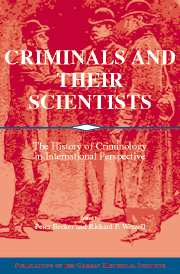Book contents
- Frontmatter
- Introduction
- Part One Nonacademic sites of Nineteenth-Century Criminological Discourse
- Part Two Criminology as Scientific and Political Practice in the Late Nineteenth and Early Twentieth Centuries
- Part Three The Making of the Criminologist
- 13 The International Congresses of Criminal Anthropology: Shaping the French and International Criminological Movement, 1886-1914
- 14 Making Criminologists: Tools, Techniques, and the Production of Scientific Authority
- 15 “One of the Strangest Relics of a Former State”: Tattoos and the Discourses of Criminality in Europe, 1880-1920
- 16 What Criminals Think about Criminology: French Criminals and Criminological Knowledge at the End of the Nineteenth Century
- 17 Talk of the Town: The Murder of Lucie Berlin and the Production of Local Knowledge
- Part Four Criminology in the First Half of the Twentieth Century: The Case of Weimar and Nazi Germany
- Index
17 - Talk of the Town: The Murder of Lucie Berlin and the Production of Local Knowledge
Published online by Cambridge University Press: 05 January 2013
- Frontmatter
- Introduction
- Part One Nonacademic sites of Nineteenth-Century Criminological Discourse
- Part Two Criminology as Scientific and Political Practice in the Late Nineteenth and Early Twentieth Centuries
- Part Three The Making of the Criminologist
- 13 The International Congresses of Criminal Anthropology: Shaping the French and International Criminological Movement, 1886-1914
- 14 Making Criminologists: Tools, Techniques, and the Production of Scientific Authority
- 15 “One of the Strangest Relics of a Former State”: Tattoos and the Discourses of Criminality in Europe, 1880-1920
- 16 What Criminals Think about Criminology: French Criminals and Criminological Knowledge at the End of the Nineteenth Century
- 17 Talk of the Town: The Murder of Lucie Berlin and the Production of Local Knowledge
- Part Four Criminology in the First Half of the Twentieth Century: The Case of Weimar and Nazi Germany
- Index
Summary
The newspaperman from the Berliner Tageblatt had taken the streetcar to the northern precincts of the city, to the corner of Franseckistrasse and Oderbergerstrasse, where the young girl, Margarete Koschorreck, had been murdered a few days earlier. The reporter walked along Franseckistrasse: In a bar across from the Schultheiss brewery he overheard conversations among patrons discussing a newspaper article about the crime, walked past the “blood-red” reward notices still pasted on the Litfasssäulen, or advertising pillars, and, finally, at the murder scene at Franseckistrasse Number 39, stumbled across two little girls on little chairs in front of a junk store absorbed by an account of the murder, slowly reading every word out loud. This story is revealing because it points to the increasingly textual nature of knowledge about the city. At every step, in streetcars, in bars, and in shops, Berliners debated and pored over newspaper articles; along Franseckistrasse they confronted advertisements and police notices. These illustrate not only that reading had become commonplace in even the most proletarian districts of Berlin but that reading about the city had become a habitual way of apprehending the city. The newspaperman's encounter on Franseckistrasse is also revealing because it re-enacted what was still a novelty among big city newspapers, namely, sending observers to far-flung outskirts to report on working-class lives in feuilletonistic detail.
- Type
- Chapter
- Information
- Criminals and their ScientistsThe History of Criminology in International Perspective, pp. 377 - 398Publisher: Cambridge University PressPrint publication year: 2006
- 4
- Cited by

